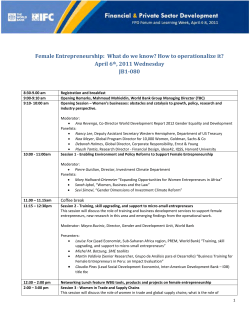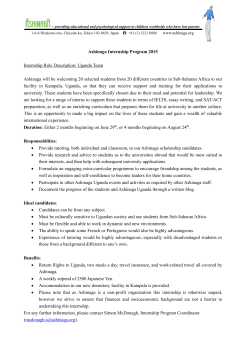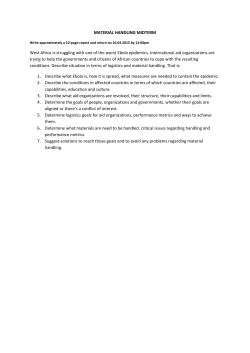
The Unfinished Health Agenda in Sub
March 19, 2015 The Unfinished Health Agenda in Sub-Saharan Africa Prepared statement by Thomas J. Bollyky Senior Fellow for Global Health, Economics, and Development Council on Foreign Relations Before the Senate Foreign Relations Subcommittee on Africa and Global Health Policy United States Senate First Session, 114th Congress Hearing on the U.S.-Africa Leaders Summit Seven Months Later: Progress and Setbacks Chairman Flake, Ranking Member Markey, and other distinguished members of the Subcommittee: I am grateful for this opportunity to testify about global health in sub-Saharan Africa, the progress and setbacks that have occurred in this sector since last year’s African Leaders Summit, and their implications for private sector-led growth in the region. Better health has improved the climate for private investment in sub-Saharan Africa, but developments since the African Leaders Summit have revealed the fragility of those gains. The prospects for more private sector-led growth in sub-Saharan Africa depend on continued U.S. leadership on global health, especially on emerging infectious diseases, like Ebola, and to address the stunningly fast rise of cancer, diabetes, and cardiovascular and other noncommunicable diseases (NCDs) in the region. The Council on Foreign Relations takes no institutional positions on policy issues and has no affiliation with the U.S. government. All statements of fact and expressions of opinion contained herein are the sole responsibility of the author. U.S. Role in Improved Health in Sub-Saharan Africa U.S. leadership has played a significant role in improved health in sub-Saharan Africa. A dozen years ago, an HIV/AIDS epidemic that first hit wealthy countries spread the quickest in sub-Saharan Africa, causing large numbers of premature adult deaths and shaking governments. The United States responded. The U.S. President’s Emergency Plan for AIDS Relief (PEPFAR) and U.S. support for The Global Fund to Fight AIDS, Tuberculosis, and Malaria delivered lifesaving antiretroviral treatments to millions in the region. The United States expanded its health investments in sub-Saharan Africa in other areas as well, from childhood immunization to nutrition to maternal health. Those investments helped inspire a surge of attention and resources for health in the region from other donors, the private sector, and local governments. Over the past decade, U.S. support for better health in sub-Saharan Africa has been sustained, bipartisan, and cost-effective. The United States is the leading contributor of global health aid, which accounted for just 0.23 percent of U.S. spending in 2013. The returns on that investment in sub-Saharan Africa, however, have been remarkable. Since the rollout of the PEPFAR program in 2004, premature death and disability from HIV/AIDS in subSaharan Africa have dropped 17 percent.1 Infant mortality is down nearly 20 percent in the region since 2000, which has meant 700,000 more children now survive their fifth birthday.2 Premature death and disability from malaria and tuberculosis in sub-Saharan Africa have declined 23 percent and 13 percent, respectively. The gains from improved health in sub-Saharan Africa have not only been humanitarian, however. A decade ago, Coca-Cola reported routinely hiring two workers for every job opening in sub-Saharan Africa due to the likelihood that one worker might become terminally ill.3 South African mining companies reported HIV and TB infection rates among their workers that were some of the highest in the world. A more stable, healthier labor force and an increase in working-age adults due to lower child mortality have spurred economic growth and private investment in sub-Saharan Africa. A recent Lancet commission, led by former U.S. Treasury Secretary Larry Summers and the health economist Dean Jamison, concluded 2 improvements in life expectancy in sub-Saharan Africa between 2000 and 2011 contributed to a nearly six percent annual increase in full income, the sum of national income plus the value of the change in mortality (Figure 1). U.S. private-sector investments in sub-Saharan Africa over the past decade have yielded among the highest rates of return of any region in the world.4 Contributions of Changes in Life Expectancy to Full Income5 Adapted from Jamison, Summers, et al., The Lancet 382 (2013). The benefits of continued private investment and economic growth in sub-Saharan Africa would accrue to the United States as well. Wealthier sub-Saharan African countries are less U.S.-aid dependent, more stable, and better trade and strategic partners. As personal incomes grow, many of these countries’ demand for exports will rise and begin to shift to the categories in which the United States leads the world: civilian aircraft, pharmaceuticals, machinery and equipment, high-value foods, and entertainment. The improved economic and strategic prospects in the region encouraged the White House to hold the first ever U.S.–Africa Summit in August 2014. The Summit offered the opportunity not only to expand on health gains, but also encourage more private investment in energy and infrastructure and forge closer diplomatic ties. 3 The health initiatives announced at the Leaders Summit included: a PEPFAR and Children’s Investment Fund Foundation partnership to prevent mother to child transmission of HIV; a U.S.-African private sector initiative on food security and nutrition; and a PEPFAR/Pink Ribbon Red Ribbon initiative on cervical cancer screening in Ethiopia and Namibia, supported by General Electric, GlaxoSmithKline, and others. Health in sub-Saharan Africa since the Leaders Summit In months after the Summit, it has become clear that new health challenges are emerging in sub-Saharan Africa. The region has one of the fastest rates of urbanization in the world. Most of that growth is in smalland medium-sized cities with limited public health infrastructure.6 Inter- and intra-country trade in the region is increasing, but its oversight lags behind. Many sub-Saharan countries lack the basic consumer protections and public health rules that have been in place in most high-income countries for decades. Life expectancies have improved in sub-Saharan Africa, but without the same gains in personal income and health systems that accompanied longevity in wealthier countries. The median GDP per capita in OECD countries was $4376 when they achieved a median life expectancy of 60 years in 1947. Sub-Saharan African nations just reached that life expectancy in 2011 and their median GDP per capita was $1658.7 The health systems in most sub-Saharan African countries are still built for acute care, not chronic or preventative care. Health spending has increased in recent years, but remains low relative to high-income countries.8 All the governments in sub-Saharan Africa together spend roughly as much on health annually ($33 billion) as the government of Poland ($31 billion). 9 Two developments in the months since the African Leaders Summit demonstrate the health consequences of these trends and the fragility of the recent gains in sub-Saharan Africa. The most high profile example is the Ebola outbreak in West Africa, which began before the African Leaders Summit, but accelerated thereafter. Prior to the current epidemic, Ebola had killed fewer than 2,000 people in 28 outbreaks since the virus was first identified in 1976, all in Central Africa. Ebola has killed nearly five times that number in the last fourteen months, with enough cases spreading internationally to 4 dominate nightly news broadcasts and affect recent U.S. elections. The difference? With greater trade and travel to and within the region, emerging infectious diseases like Ebola are less likely to burn out in rural villages and more likely to reach the crowded cities with limited health systems that are the ideal incubators for outbreaks. The Ebola outbreak may be just a preview of pandemics to come in sub-Saharan Africa. Through the combined efforts of the local and international responders, the Centers for Disease Control and Prevention and other U.S. agencies, donors, and intergovernmental institutions, new Ebola cases appear finally to be dwindling. The economic cost, however, remains. The most recent World Bank estimates are that Sierra Leone, Liberia, and Guinea will lose $1.6 billion in economic output in 2015 alone, more than 12 percent of their combined GDP. The Ebola outbreak’s projected 2015 economic costs in other sub-Saharan African countries is just over half a billion dollars, to be experienced mostly in West Africa.10 A second example of changing global health needs is the stunningly fast increase of heart disease, cancers, and other NCDs in sub-Saharan Africa. Once thought to be challenges for affluent countries alone, these diseases have quickly become a leading health concern in sub-Saharan Africa, causing as much death and disability in the region as HIV/AIDS, malaria, and maternal disorders combined. A new Council on Foreign Relations (CFR)-sponsored Independent Task Force report, co-chaired by former Indiana Governor Mitch Daniels and former U.S. National Security Advisor Tom Donilon, found that NCDs are increasing in sub-Saharan Africa faster, in younger people, and with worse outcomes than in wealthier countries.11 Citing data from the Institute for Health Metrics and Evaluation’s groundbreaking Global Burden of Disease project, the Task Force showed that NCD death and disability increased 33 percent between 2000 and 2013, more than 200 percent faster than the decline of infectious diseases in the region, The increase of death and disability of breast cancer and diabetes in the region exceeded 80 percent over the last two decades. More than 80 percent of the NCD burden in sub-Saharan Africa arises in people 59 years of age or younger. Rates of the most unhealthy behaviors associated with NCDs remain low in sub-Saharan Africa. U.S. adult obesity is more than four times higher than it is in sub-Saharan Africa.12 The major drivers of these diseases 5 in this region are the same as in the Ebola outbreak: limited health systems, persistent poverty, and risks fueled by urbanization and changes in trade. Inhabitants of densely packed urban areas often face pollution outdoors and the burning of fuels indoors, are more likely to buy tobacco products, and less likely to have access to adequate nutrition. With little access to preventative care and more exposure to these health risks, working-age people in sub-Saharan Africa are more likely to develop an NCD. Without access to chronic care and limited household resources to pay for medical treatment, these people are more likely to become disabled and die young as a result. The Task Force found that, unless urgent action is taken on NCDs, the economic consequences in subSaharan Africa will be significant. Most NCDs are chronic, as is the case with HIV/AIDS. As more patients get sick from NCDs, suffer longer, require more medical care, and die young, the results reverberate. At the household level, it means less income and catastrophic health expenditures. At the national level, it means lower productivity and competitiveness, and a potential missed opportunity to capitalize on the demographic dividend that lifted the fortunes of many higher-income countries. At the global level, the World Economic Forum projects that the NCD epidemic will inflict $21.4 trillion in losses in developing countries over the next two decades—a cost nearly equal to the total aggregate economic output ($24.4 trillion) of these countries in 2013. These economic costs will undercut potential U.S. trade partners and allies and undermine existing U.S. and private sector investments in sub-Saharan Africa. The Unfinished Health Agenda in Sub-Saharan Africa Progress on the unfinished health agenda in sub-Saharan Africa is possible. The Global Health Security Agenda and the recent resources that Congress has devoted to it provide an excellent start. There is a critical need to invest in basic public health systems in the region, especially primary health care facilities, laboratories, surveillance systems, and critical care facilities. The use of these systems should not be limited to disease-specific goals, but be responsive to local needs. The public health surveillance and response must be used regularly for routine matters in order to be efficiently scaled in the extraordinary circumstances of an outbreak. 6 Strengthening health care systems improves our ability to deal with emerging infectious diseases, but also provides a platform for the preventative and chronic care desperately needed for NCDs. Without better functioning health systems, it will be very hard for sub-Saharan Africa to end the cycle of disease and poverty and promote private sector-led growth. Despite much higher rates of obesity and physical inactivity, premature death and disability from NCDs has declined dramatically in the United States and other high-income countries. The reason? Mostly cheap and effective prevention, management, and treatment tools and policies that are not widely implemented in subSaharan Africa, but could be with well-established global health strategies. These include low-cost drugs to reduce heart attacks, vaccines to prevent cervical cancer, and providing countries with the opportunity to implement the same tobacco taxes and advertising rules that dramatically cut smoking rates in the United States. Pilot programs can and have integrated these tools and policies into donor-funded programs on HIV/AIDS and other public health system platforms in the region. The private sector has a twofold role on unfinished health agenda in sub-Saharan Africa. First, the private sector is best suited to invent and adapt technologies for diagnosis, prevention, and treatment of emerging infectious diseases and NCDs in low-infrastructure settings. Second, companies have natural concerns for maintaining the health and productivity of their workforces and the size and purchasing power of their customer base. Large employers were essential to rally global support for addressing HIV/AIDS in the region. They are also at the forefront of designing and implementing innovative health promotion programs for their employees that emphasize exercise, preventative care, better diets, and reduced smoking. The hard work and generosity of the United States, the private sector, and other donors have helped reduce the plagues, parasites, and blights that have long undercut economic opportunity and investment in subSaharan Africa. Extending those initiatives to NCDs and emerging infectious diseases would lessen their worst effects and provide national governments with the time and technical assistance needed to tackle these new threats sustainably on their own. Continued U.S. and private sector leadership on the unfinished health agenda in Africa is as important now as it has been in the past and for the same reasons: a peaceful, inclusive economy presupposes healthier, more productive lives. 7 Murray, Christopher JL, Katrina F. Ortblad, Caterina Guinovart, Stephen S. Lim, Timothy M. Wolock, D. Allen Roberts, Emily A. Dansereau et al. "Global, regional, and national incidence and mortality for HIV, tuberculosis, and malaria during 1990–2013: a systematic analysis for the Global Burden of Disease Study 2013." The Lancet 384, no. 9947 (2014): 1005-1070. 2 Wang, Haidong, Chelsea A. Liddell, Matthew M. Coates, Meghan D. Mooney, Carly E. Levitz, Austin E. Schumacher, Henry Apfel et al. "Global, regional, and national levels of neonatal, infant, and under-5 mortality during 1990–2013: a systematic analysis for the Global Burden of Disease Study 2013." The Lancet 384, no. 9947 (2014): 957-979. 3 Krisi Heim, “Corporations Invest in Global Health,” Seattle Times, November 11, 2010, http://seattletimes.nwsource.com/html/businesstechnology/2013410811_fireconference12.html. 4 Sveinung Fjose, Leo A. Grünfeld, and Chris Green, “SMEs and growth in Sub-Saharan Africa,” MENON Business Economics, June 2010, http://www.norfund.no/getfile.php/Documents/Homepage/Reports%20and%20presentations/Studies%20for%20Norfund/SM E%20and%20growth%20MENON%20%5BFINAL%5D.pdf. 5 Adapted from Dean T. Jamison, Lawrence H. Summers, George Alleyne, Kenneth J. Arrow, Seth Berkley, Agnes Bingawaho, Flavia Bustreo, et al., “Global health 2035: a world converging within a generation,” The Lancet 382 (2013): 1898–955, doi: 10.1016/S0140-6736(13)62105-4. 6 Julie E. Fischer and Rebecca Katz, “The International Flow of Risk: The Governance of Health in an Urbanizing World,” Global Health Governance 4 (2011); Campbell et al., “Emerging Disease Burdens,” i59. 7 Council on Foreign Relations, Noncommunicable Disease Interactive, available at http://www.cfr.org/diseasesnoncommunicable/NCDs-interactive/p33802. 8 Institute for Health Metrics and Evaluation, “Financing Global Health 2013: Transition in an Age of Austerity,” Institute for Health Metrics and Evaluation, 2014, 61-62, http://www.healthdata.org/policy-report/financing-global-health-2013-transitionage-austerity. 9 OECD Health Stats: Public Health Expenditure since 2000, via Organization for Economic Co-operation and Development, http://stats.oecd.org/index.aspx?DataSetCode=HEALTH_STAT. 10 World Bank, The Economic Impact of Ebola on Sub-Saharan Africa:Updated Estimates for 2015 (Jan. 20, 2015). 11 Thomas J. Bollyky, Mitchell E. Daniels, and Thomas E. Donilon. The emerging global health crisis: noncommunicable diseases in low- and middle-income countries. New York, NY: Council on Foreign Relations, 2014. Print. 12 Ng, Marie, Tom Fleming, Margaret Robinson, Blake Thomson, Nicholas Graetz, Christopher Margono, Erin C. Mullany et al. "Global, regional, and national prevalence of overweight and obesity in children and adults during 1980–2013: a systematic analysis for the Global Burden of Disease Study 2013." The Lancet 384, no. 9945 (2014): 766-781. 1 8
© Copyright 2025









